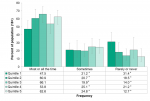Sleep
Sleep
Healthy sleep can help reduce the risk of disease and includes getting good quality sleep in the right amounts. Too little or too much sleep has been associated with many chronic conditions such as hypertension, obesity and depression.1 About half the population of Middlesex-London aged 12 and older met the guidelines for sleep, specific to their age, in 2015/16. About 40% of the population reported getting less sleep than the recommended guidelines; getting only five to seven hours, on average, per night. One in five people reported difficulty sleeping, such as trouble getting to sleep or staying asleep and trouble staying awake when desired.
| Meeting Sleep Guidelines | Difficulty Sleeping |
Meeting Sleep Guidelines
About half the population of Middlesex-London (52.8%) aged 12 and older met the guidelines for sleep, specific to their age, in 2015/16. No significant differences were seen by sex, age or other sociodemographic factors. Middlesex-London rates were similar to Ontario and the Peer Group (Figure 6.1.1).
Over a third of adults between 18 and 64 (35.6%) slept between seven and eight hours, on average, each night, while 16.0% slept between eight and nine hours. Nearly 40% (39.4%) slept, on average, between five and seven hours. Numbers of people who reported sleeping more than nine hours or less than five hours were very small (Figure 6.1.2).
Interpretation
Guidelines through the National Sleep Foundation indicate that adults (18-64) should sleep between seven and nine hours, while older adults (65+) need seven to eight hours.2 According to Statistics Canada, nearly two thirds of the Canadian population met the recommendations of the sleep guidelines between 2007 and 2013. This is more than the half of the Middlesex-London population reported to have met the guidelines in 2015/16. While no differences in meeting guidelines or average hours of nightly sleep were seen by socioeconomic differences in Middlesex-London, research indicates that those with higher education and incomes are more likely to meet the guidelines than their counterparts.3
Difficulty Sleeping
Nearly one in five adults aged 18 and older (18.3%) reported that, most or all of the time, they had trouble going to sleep or staying asleep. This compared to just over half (55.0%) who rarely or never had difficulty (Figure 6.1.3).
Nearly one in five adults aged 18 and older (19.1%) reported that they rarely or never found sleep refreshing. This compared to over half (58.1%) who did find sleep refreshing most or all of the time. (Figure 6.1.4).
As income level decreased, there was an increase in the percent of people who reported sleep was not refreshing. 31.4% of those in the lowest income quintile (Q1) report that they rarely or never found sleep refreshing compared to 12.7% of those in the highest income quintile (Figure 6.1.5).
More than a quarter of the population of adults aged 18 and older reported difficulty staying awake when they wanted to. Residents of Middlesex-London reported sometimes having difficulty (22.9%) and an additional 5.6% reported having difficulty most or all of the time. There were no significant differences between Middlesex-London and Ontario or its peer group comparators (Figure 6.1.6).
Interpretation
Both sufficient amounts of sleep and quality of sleep are important factors associated with chronic disease. Although local data is not analyzed at this level, Canadian research suggests that those who met the sleep recommendations and slept the average number of recommended hours at night reported better sleep quality.3
Population Health Assessment and Surveillance Protocol, 2018
References:
1. Colten HR, Altevogt BM, editors. Sleep disorders and sleep deprivation: an unmet public health problem [Internet]. Washington (DC): National Academies Press; 2006 [cited 2019 Apr 17]. 425 p. Available from: https://www.ncbi.nlm.nih.gov/books/NBK19960/
2. Hirshkowitz M, Whiton K, Albert SM, Alessi C, Bruni O, DonCarlos L, Hazen N, Herman J, Hillard PJ, Katz ES, Kheirandish-Gozal L, Neubauer DN, O’Donnell AE, Ohayon M, Peever J, Rawding R, Sachdeva RC, Setters B, Ware JC. National Sleep Foundation’s updated sleep duration recommendations: final report. Sleep Health [Internet]. 2015 Dec [cited 2019 Apr 17];1(4):233–43. Available from: https://www.sciencedirect.com/science/article/abs/pii/S2352721815001606?...
3. Chaput J-P, Wong SL, Michaud I. Duration and quality of sleep among Canadians aged 18 to 79. Health Rep [Internet]. 2017 Sep 20 [cited 2019 Apr 17];28(9):28–33. Available from: https://www150.statcan.gc.ca/n1/pub/82-003-x/2017009/article/54857-eng.htm
4. Canadian Society for Exercise Physiology. Canadian 24-Hour Movement Guidelines: An Integration of Physical Activity, Sedentary Behaviour, and Sleep [Internet]. Ottawa (ON): Canadian Society for Exercise Physiology; c2019 [cited 2019 Apr 17]. Available from: https://csepguidelines.ca/
Last modified on: July 9, 2019
Jargon Explained
Sleep Guidelines
Adults aged 18 to 64 need 7 to 9 hours of sleep a night and adults aged 65 and older need 7 to 8 hours a night.2
Sleep Guidelines in Youth
12 and 13 years olds need between 9 and 11 hours per night and 14-17 year olds should have between 8 and 10 hours per night, with consistent bed and wake-up times.4





